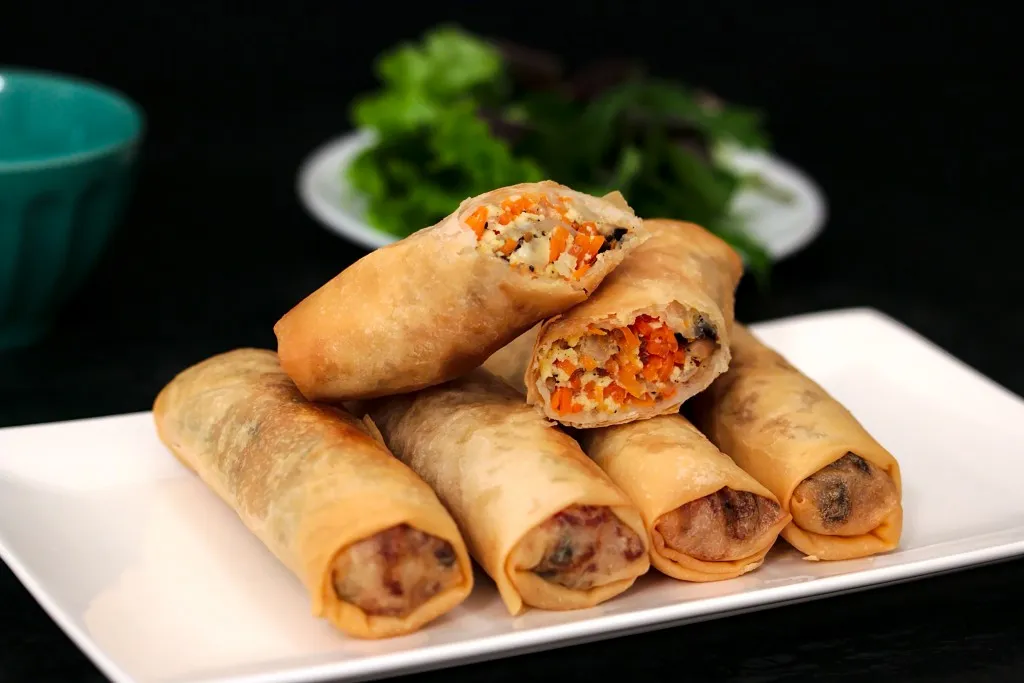Vietnamese egg rolls, known as Chả Giò in Vietnam, are a unique and tantalizing appetizer. Their distinct blend of flavors and textures sets them apart from other Asian egg roll varieties. At their core, these crispy rolls contain pork, taro, mushrooms, carrots, and bean sprouts wrapped in delicate rice paper and deep fried to perfection. However, Chả Giò can vary greatly by region, with some versatile cooks even incorporating crab, shrimp, chicken and additional vegetables. Trying this exceptional street food is a must for any adventurous foodie exploring Vietnam.
The History of Chả Giò
While many Asian cultures have their own version of egg rolls, Chả Giò originated right in Vietnam. These crispy rolls have roots dating back centuries in Vietnamese culture. In the past, Chả Giò was often served for Tết, the Vietnamese New Year celebration. The dish was meant to symbolize wealth because of the use of expensive pork. Over time, cooks began improvising by using less expensive ingredients too. As Chả Giò grew popular across the country, the recipe evolved greatly between regions. Now it is a staple Vietnamese appetizer found everywhere from high-end restaurants to casual street stalls.
Other classic Vietnamese dishes like phở and bánh mì emerged after French colonial influence. But Chả Giò predates this period, solidly establishing it as part of Vietnam’s indigenous cuisine. While the contemporary preparation methods may have Western touches, the core spirit of these rolls connects directly back through Vietnamese culture.
The Ingredients for Chả Giò
While vegetables commonly include taro, mushrooms, carrots and bean sprouts, the filling foundation is most often ground pork. However, some versions utilize shrimp, crab or chicken in place of pork to cater to religious customs or dietary preferences. Vegetarian Chả Giò also exclude the meat entirely, using additional tofu or heartier vegetables like jicama or fresh bamboo shoots.
The filling medley is wrapped inside thin, delicate rice paper wrappers. Rice flour, tapioca flour and water are blended together and steamed to create the soft wrappers. Chả Giò requires an egg wash to seal the rolls before frying. The rolls are served warm with a dipping sauce like nuoc cham on the side. Nuoc cham typically contains fish sauce, lime, garlic, sugar and chili peppers.
Vietnamese Egg Rolls: A Step-by-Step Recipe
Making Chả Giò at home is very manageable with a little practice and preparation. Here is one approach:
First, assemble the pork filling. Mix 1 lb ground pork with 2 grated carrots, 10 oz bean sprouts, 8 oz diced shiitake mushrooms and 1 small julienned jicama. Season with salt, pepper, minced garlic and nuoc cham.
Next, prep the wrappers. Dip dry rice paper sheets briefly in warm water to soften. Lay flat one at a time on a damp towel.
Now assemble the rolls. Place 2-3 tbsp of filling near the bottom of the wrapper. Fold the sides inward and roll up the wrapper tightly around the filling.
Seal with egg wash. Whisk an egg with 1 tsp water and brush it on the edge of the wrapper before rolling to hold it together.
Finally, fry the rolls. Heat 2 inches of vegetable oil to 350°F and fry a few egg rolls at a time until crispy and golden brown, about 4-5 minutes. Drain on paper towels. Serve immediately with nuoc cham or soy sauce.
The key for homemade Chả Giò is getting the wrappers just pliable enough to roll without ripping. Frying them soon after assembling ensures they stay crisp too.
Tips and Tricks for Making Perfect Vietnamese Egg Rolls
Achieving crispy, perfectly fried Chả Giò requires finesse:
- The oil must maintain a temperature of 350-375°F. Too low, and they will be greasy. Too high, and they will burn. Use a thermometer and adjust the heat to stabilize at an optimal temp.
- Let rolls drain on a paper towel-lined sheet pan right out of the fryer. The paper towels will continue wicking away excess grease.
- Don’t overload the pot when frying. Crowding will lower the oil temp and make the rolls oily. Fry in batches.
- Keep fried rolls warm on a wire rack in a 175°F oven if needed between batches.
- Fold and roll wrappers tightly so filling stays safely enclosed as they fry. Use egg wash sparingly to seal. Too much will leak out into oil.
- Don’t leave filled wrappers sitting out too long before frying or they may become soggy and tear.
Master these techniques, and you’ll be enjoying restaurant-quality Chả Giò from your own kitchen.
Enjoying Chả Giò
Chả Giò can be an appetizer, snack or light meal depending on portion size. They are typically served with a dipping sauce, most authentically nuoc cham. The savory rolls pair wonderfully with the sweet, sour, salty, spicy dip.

They also work well in lettuce wraps. Place pieces of Chả Giò and fresh herbs like mint, cilantro and basil inside lettuce leaves. Top with nuoc cham and enjoy as fun finger food.
In Vietnam, Chả Giò are popularly eaten for breakfast with phở or as bar snacks with beers. Try incorporating them into fun Vietnamese-themed meals at home too. Pair them with fresh spring rolls, phở and Vietnamese iced coffee for a delicious cultural dining experience.
Conclusion
From small street stalls to upscale Vietnamese restaurants around the world, Chả Giò are an enduring staple. Their crispy exterior hides a flavorful blend of meats, vegetables and seasonings inside a delicate wrapper. This exceptional street food has survived for generations as a symbol of Vietnamese culture and cuisine. For an authentic taste of Vietnam, be sure to try sizzling, savory Chả Giò.
